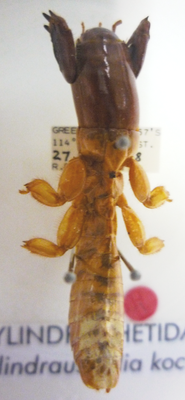Cylinderachetidae
| Cylinderachetidae | ||||||||||
|---|---|---|---|---|---|---|---|---|---|---|

|
||||||||||
| Systematics | ||||||||||
|
||||||||||
| Scientific name | ||||||||||
| Cylinderachetidae | ||||||||||
| Ermanno Giglio-Tos , 1914 |
The Cylindrachetidae are a family of Orthoptera first discovered (1832) in Northern Australia (in the Darwin area ). Due to their convergent characteristics, they were initially thought to be mole crickets , and later (because of their similar body shape) to relatives of the Embiiden . Today they are considered to be derived from Caelifera Tridactyloidea, i.e. related to grasshoppers and adapted to their subterranean way of life. In Australia the "sandgropers" are as popular as in Europe (earlier) the cockchafer , although they (like this one) are decried as pests. ("Sandgropers" is also the nickname of the Western Australians.) The animals are brownish in color; the largest reach 7 cm in length.
construction
The body is very elongated and cylindrical - this shape seems optimal for light, sandy soils, while the more compact Gryllotalpa has adapted to heavier (moist) soils. The front legs are designed for digging. The head is partly hidden under the very elongated pronotum . The thread-like feelers have 7 to 11 sections [so comparatively short]. The eyes are small and oval, the ocelles are reduced. The tarsi of the forelegs are one (or two) limbs, those of the middle legs one or two limbs, those of the hind legs one limb as well as the cerci (according to the diagnosis of E. Giglio-Tos 1914). The hind legs are weak compared to those of most other "horrors". Both sexes are completely wingless. [One therefore spoke of “larval” characteristics of these “ neotene ” animals.] The soft abdomen is cylindrical; an ovipositor is not developed. As you can see in the pictures, the whole animal is wrapped in a pile of fine hairs (the toment, as with the mole cricket, of course less dense).
biology
Little is known about biology. They are suspected of eating grass and cereal roots, but were (partly?) Confused with wireworms ; Günther was more likely to find remains of insects in the intestinal canal. The same problem exists with Gryllotalpa , of which there is also a species ( G. australis ) in Eastern Australia . The sound production ( stridulation ) is probably done by small knobs at the base of the mandibles , which are rubbed against the ridges on the maxillary palps . A delicate cuticular membrane appears to function as the tympanum distally on the tibia of the forelimbs.
Genera and species in the family Cylindrachetidae
according to ITIS as of October 18, 2009
-
Cylinderacheta Kirby, 1906 (Synonym Cylindrodes Gray, 1832)
- Cylinderacheta campbelli (Gray, 1837), N Australia
-
Cylindraustralia Günther, 1992 (mainly Australia except SE and Tasmania, mainly W-Austr.)
- Cylindraustralia acuta Günther, 1992
- Cylindraustralia arenivaga (Tindale, 1928)
- Cylindraustralia centricola Günther, 1992
- Cylindraustralia cookensis Günther, 1992
- Cylindraustralia divisa Günther, 1992
- Cylindraustralia granulata Günther, 1992
- Cylindraustralia karumbensis Günther, 1992
- Cylindraustralia kochii (Saussure, 1877) (Perth area; New Guinea)
- Cylindraustralia longaeva (Tindale, 1928)
- Cylindraustralia parakochia Günther, 1992
- Cylindraustralia parvitarsata Günther, 1992
- Cylindraustralia setosa Günther, 1992
- Cylindraustralia tindalei Günther, 1992 (area around Perth)
- Cylindraustralia ustulata (Neboiss, 1962)
-
Cylinderctes Tindale, 1928
- Cylindricctes spegazzinii (Giglio-Tos, 1914) ( Patagonia )
As a result of the Gondwana spread, the "Sandtapper" must have originated before the Cretaceous . They are therefore older than the Gryllotalpidae.
literature
- Klaus K. Günther: Revision of the family Cylinderachetidae Giglio-Tos 1914 . In: German Entomological Journal. 39. 1992, pp. 233-291.
- David CF Rentz: Grasshopper Country: The Abundant Orthopteroid Insects of Australia . University of New South Wales Press, Sydney 1996, p. 284.
Remarks
- ↑ from gr. Kylindros "roller" and acheta (Latinized for gr. (Attic) ēchetēs "singer", "cicada"; Acheta ) today (scientific) "house".
- ↑ Our mole cricket, on the other hand, can fly and also chirps with its wings. It has multiple antennae, so it belongs to the Ensifera .
- ↑ (lat.) Tomentum "padding" (hay, straw, feathers, hair, wool), "felt"
- ↑ oryktes "Graves", s. Oryctes .
